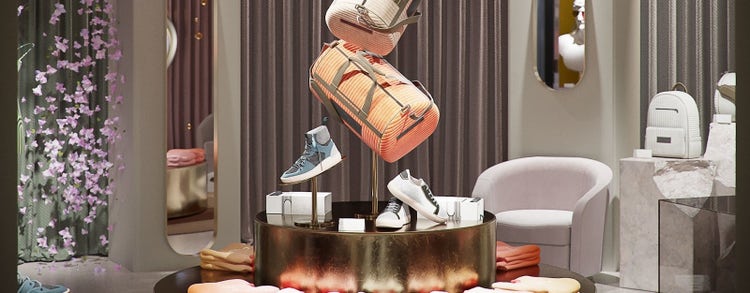Designing a concept store with Adobe Substance 3D

3D design has been on a meteoric rise over the past few years and is set to be one of the biggest trends of 2022. The technology is increasingly being used for product development, marketing campaigns, and immersive ecommerce experiences, and the tools needed to create cutting-edge 3D designs are now more accessible and affordable than ever.
It's our mission to empower all creatives to design in 3D, whether they have previous 3D experience or not. That's why we launched the Adobe Substance 3D Collection, a comprehensive suite of powerful interoperable tools and services. As part of that June 2021 release we added a collection of around 2,200 models to Substance 3D Assets, complementing the more than 8,900 materials that were already available. A large chunk of these new assets, created in close collaboration between Adobe and expert partners, is aimed at helping creatives stage interior design, 3D architecture, and retail scenes.
To showcase the versatility of these 3D models and materials and how they can boost an artist’s workflow efficiency, we invited Daniel Margunato, co-founder and lead artist at Oneblock.city, a creative studio specializing in the visualization of architecture, to design a realistic concept store populated with assets from this release.
Importing ready-to-use models and texturing into the scene
Our brief challenged Margunato to create a luxury showroom that could exist in the real world and featured Substance 3D assets, which online shoppers could customize to try out products and pick the version they preferred. If they selected a pair of shoes, for example, they would be able to choose between a few different finishes like a specific leather.
In collaboration with the Substance team, Margunato defined a mood board and decided on a palette of colors and materials.
“The key challenge here was to give the products on display a raw, unfinished look, while still making them attractive,” Margunato explains. “As the whole raison d’être of the project was to showcase the quality and versatility of the assets, we didn’t want the hero assets to look as if they were untextured. So we decided to customize some of the products — some would serve more as inspiration for potential customers, while others would remain neutral and customizable.”
Margunato selected a range of ready-to-use models from the Substance 3D Asset library (such as clothes, footwear, and accessories) and then used Substance 3D Painter to texture the hero assets, while the textures for the others were directly dragged-and-dropped from Substance 3D Assets. Some of the elements — the curtains, the central stand, and the pillars — only needed to accentuate the hero assets and therefore didn’t require detailed texturing. The quality of these elements was still important, though, as they played a significant role in lending credibility to the overall scene.
“The production phase moved forward very quickly,” Margunato recalls. “Using models from Substance 3D Assets proved very straightforward. The models are detailed and already unwrapped — in other words, they come ready to texture. No preparation is needed — you can just open them in Substance 3D Painter and start painting, which allowed me to iterate very rapidly. I only adjusted the UV maps of the hero assets a little bit to scale the models up.”


Adding precision and meticulous details
Ecommerce experiences are especially effective when you show closeups of the products, and so Margunato worked on making the products on display in the central section of the scene as realistic as possible.
He used displacement in Substance 3D Painter to add some precise details to the rubber soles of the shoes and give the simple model of the bag a more luxurious feel. This way of working provided Margunato with a lot of flexibility. If he had to tweak the details at any point, he just needed to edit the appropriate mask.
Margunato also used Painter to create the detailed stitching of the shoes and the labels on the bags. The bags’ padded material and the leather are both Smart Materials, also built in Painter, that could automatically adapt to other 3D models, which made creating a cohesive collection a breeze.
For the sequence with the dress Margunato wanted to convey the feeling of motion, and as the original model was too static in the context of his design, he opted for a simple workflow to make it more dynamic: First, he used the unwarp feature to extract the sewing pattern and imported it into Marvelous Designer. Then he selected a ready-to-use model with a dynamic position in Mixamo, which he imported into Marvelous Designer to place the dress on it. Finally, Painter was used to put the finishing touches to the dress.
Substance 3D enables creative freedom and flexibility
The 360º render of Margunato’s finished concept store is a great example of how 3D technology can be used to create an immersive ecommerce experience that boosts customer engagement.
The workflow that was adopted to create the photorealistic scene also shows how much flexibility the Substance 3D Collection offers creatives. From the first draft to the last render, the 2000+ new ready-to-texture models and materials in the Substance 3D Asset library save creatives a huge amount of time and money in staging retail scenes in 3D, enabling them to quickly try out ideas and customize assets to fit their particular project.
This productivity boost is enhanced further thanks to Substance 3D’s seamless integration with other Adobe Creative Cloud apps as well as industry-leading 3D tools such as 3ds Max and Marvelous Designer. This ecosystem of connected tools, which gives creatives everything they need to create state-of-the-art 3D designs, will evolve further in 2022 and transform what 3D means for creativity. We can’t wait to share further innovative use cases with you.
Sign up for a 30-day trial and try out the Substance 3D Collection yourself.